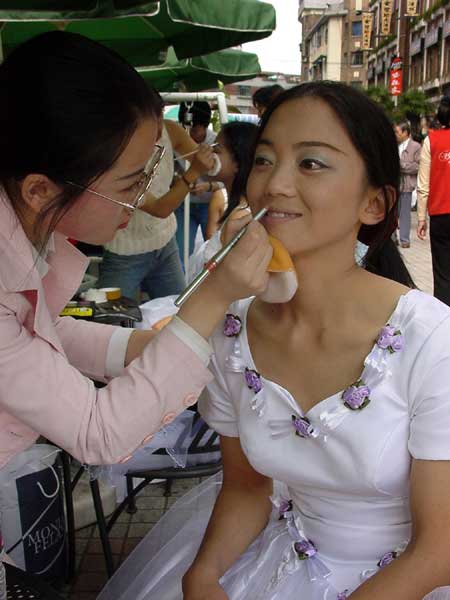Economy
Skincare items popular despite cost
By Yu Tianyu (China Daily)
Updated: 2010-09-06 10:33
 |
Large Medium Small |
|
 |
|
A woman has makeup applied at a street stall in Shanghai. China's skincare product market has developed from $44.83 billion compound annual growth rate in 2002 to $66.6 billion in 2009 and is expected to reach $77.84 billion by 2012, said Serene Wong, CEO of TNS in China. Gao Feng / Bloomberg |
BEIJING - Beijing office worker Susie Zhang is a skincare manufacturers' dream come true.
The 29-year-old routinely squanders half of her 4,000 yuan monthly salary on facial-care products alone.
A peek in her bathroom reveals a wide array of colorful bottles filled with various liquids and creams lined up like soldiers in formation.
Included are many of the products Zhang applies to her face every morning, including toners, serums, moisturizing lotions, eye creams, sunscreens, makeup base, liquid foundation and loose powder.
"Every evening, I use even more skincare products including scrubs, facial masks and many others. I think skincare and beauty products are an investment that pays you back," said the advertising industry worker.
Just like Zhang, about 68 percent of Chinese consumers agree that spending time and money on their personal appearance is an important aspect of achieving a state of well-being, a report by research firm TNS Research International.
Serene Wong, CEO of TNS in China, said that the skincare product market in China has leapt from $44.83 billion compound annual growth rate (CAGR) in 2002 to $66.6 billion in 2009 and is expected to reach $77.84 billion by 2012. Compound annual growth rate is the year-over-year growth rate of an investment over a specified period of time.
According to the latest report by market research company RNCOS, the Chinese health and beauty aids market is the second largest in the Asia-Pacific region after Japan and the seventh largest in the world.
Data from the RNCOS' report states that an extremely low penetration level and the vast consumer base in China are the two key factors that are catching the attention of skin care manufacturers around the world.
|
|||||||
However, according to Yu Xiaodong, director of the Public Nutrition and Development Center under the National Development and Reform Commission (NDRC), Chinese society has been overwhelmed by advertising that touts these products as a requirement in the pursuit of a healthy and quality lifestyle.
However, the average person in China spends roughly $5 annually on these products, the equivalent of 3 percent of Japanese and 6 percent of people in the US.
Addressing the First Skin Nutrition and Health Care Industry Forum held in Beijing in late May, Yu stressed that skincare product industry is still growing by leaps and bounds.
Wong said facial moisturizers are the most popular in China, occupying 69 percent of market sales, while facial cleaners account for 14 percent.
Skin whitening or brightening solutions or creams are also very popular with consumers in the skin care categories, applicable to all ages of Chinese consumers, she said.
Pseudo skincare queen Susie Zhang said Chinese have long prized a white complexion as shared in the old proverb, "A white complexion is powerful enough to hide a thousand facial flaws."
But Chen Hongduo, vice-president of the International Society of Cosmetic Dermatology, expressed concern over the aggressive use of these products by Chinese consumers.
"China's booming economy has greatly boosted demand for skincare and health in the country. But some misunderstandings do exist among Chinese consumers when they're going all out in the pursuit of better skin," the skin scientist said.
The awareness about skin care and protection has improved a lot in the past few years, but, they still lack some basic knowledge, he said, adding that the major problem is that the expectations of consumers has exceeded the current development level of skincare and beauty technologies.
Hopefully, not led astray by sexy advertisements, Chinese consumers need to have professional skincare assessments and guidance when buying cosmetics and skin care products, Chen said.


